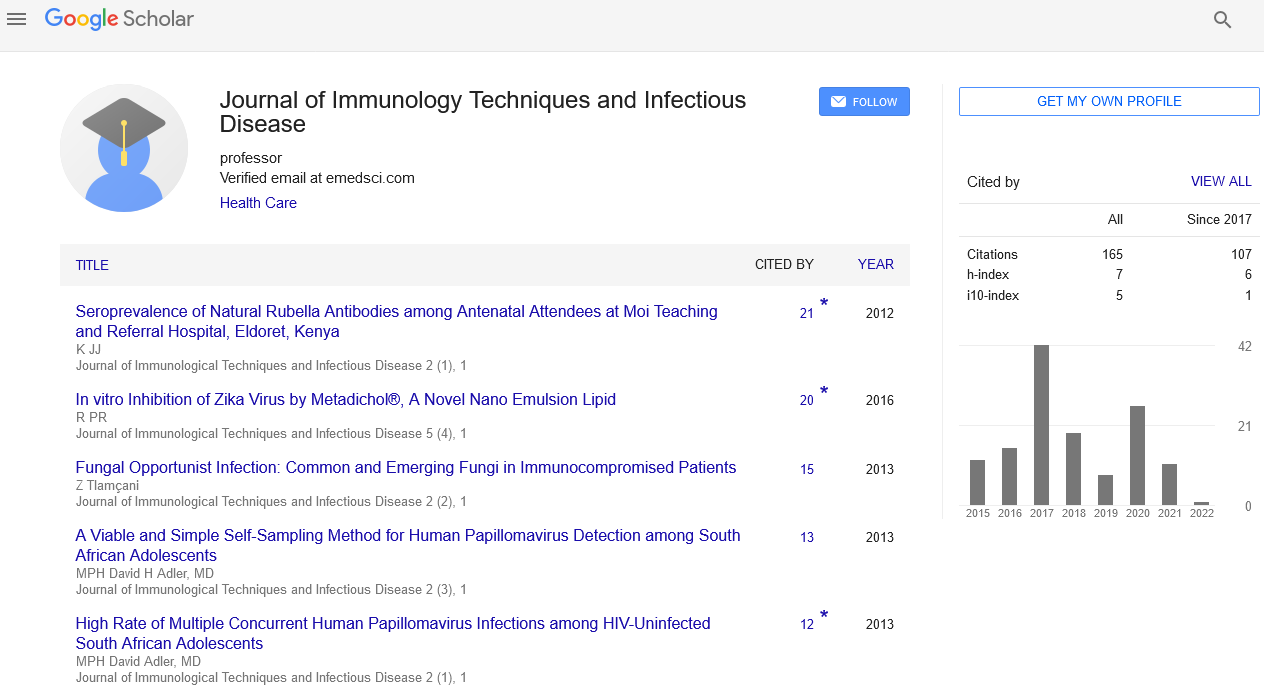Commentary, J Immunol Tech Infect Dis Vol: 13 Issue: 3
Microbiology: The Structure, Impact and Potential of Microorganisms
Sheela Bhat*
1Department of Microbiology, Pondicherry Institute of Medical Sciences, Puducherry, India
*Corresponding Author: Sheela Bhat,
Department of Microbiology, Pondicherry
Institute of Medical Sciences, Puducherry, India
E-mail: bhasheel@gmail.com
Received date: 26 August, 2024, Manuscript No. JIDIT-24-151955;
Editor assigned date: 28 August, 2024, PreQC No. JIDIT-24-151955 (PQ);
Reviewed date: 11 September, 2024, QC No. JIDIT-24-151955;
Revised date: 18 September, 2024, Manuscript No. JIDIT-24-151955 (R);
Published date: 25 September, 2024, DOI: 10.4172/2329-9541.1000394
Citation: Bhat S (2024) Microbiology: The Structure, Impact and Potential of Microorganisms. J Immunol Tech Infect Dis 13:3.
Description
Vaccines Microbiology is the study of microorganisms; tiny life forms that are frequently invisible to the human vision, but significantly damage human health, the environment and industry. These organisms include bacteria, viruses, fungi, archaea and protists, each with unique characteristics and roles in various ecosystems. Microbiology is a broad and dynamic field, encompassing diverse areas of study including microbial genetics, ecology, physiology and immunology. Through examining the structure, function and behavior of microbes, scientists have gained insights into fundamental biological processes and developed innovative solutions to address health, environmental and industrial challenges.
Types of microorganisms
There are some of the important types of microorganisms includes.
Bacteria are single-celled organisms without a nucleus (prokaryotes). They come in various shapes, including spheres, rods and spirals and can be found almost everywhere. Bacteria can be beneficial, like those in the human gut that aid digestion or harmful, like those causing diseases such as tuberculosis.
Viruses are acellular, meaning they lack a cellular structure and are composed of genetic material (DNA or RNA) encased in a protein coat. They require a host cell to replicate and are known to cause diseases such as influenza, HIV and COVID-19.
Fungi include yeasts, molds and mushrooms. Some funguses are microscopic; others are macroscopic. They play essential roles in decomposition, nutrient cycling and even in food production, contains bacteria in making bread and fermentation operations.
Similar in appearance to bacteria, archaea are distinct in genetic development and metabolic processes. They are usually found in extreme environments and play important roles in nutrient cycling and methane production.
Protists are a diverse group of eukaryotic microorganisms, including amoebas, algae and paramecia. They can be free-living or parasitic and are essential in aquatic food webs and oxygen production through photosynthesis.
The role of microbes in human health
Microorganisms play complex roles in human health, both beneficial and harmful. While some microbes cause infections and diseases, others are essential for maintaining physiological balance and developing overall health.
The human body contains millions of bacteria known as the microbiome. For example, the gut microbiome consists of bacteria that help to break down food, produce vitamins and protect against pathogens. Studies have shown that an imbalance in the gut microbiome, known as dysbiosis, can contribute to various health conditions, including inflammatory bowel disease, obesity and even mental health disorders. Understanding the microbiome has opened up new avenues for developing probiotics and other therapeutic approaches to restore microbial balance and improve health outcomes.
While many microbes are beneficial, some pathogens can cause infections and diseases. A bacterium such as Staphylococcus aureus and Escherichia coli and viruses includes influenza and hepatitis pose serious health threats. Microbiologists work to understand how these pathogens interact with the host immune system, how they evade immune responses and how they develop resistance to antibiotics. This study is essential in developing vaccines, antimicrobial therapies and infection control strategies to protect public health.
Challenges and future directions in microbiology
Despite the many advances in microbiology, there are still challenges and areas requiring further investigation. For example, antibiotic resistance is a increasing difficulty that provides a significant threat to public health. Bacteria are evolving resistance to commonly used antibiotics, making infections harder to treat and necessitating the development of new antimicrobial drugs.
 Spanish
Spanish  Chinese
Chinese  Russian
Russian  German
German  French
French  Japanese
Japanese  Portuguese
Portuguese  Hindi
Hindi 
